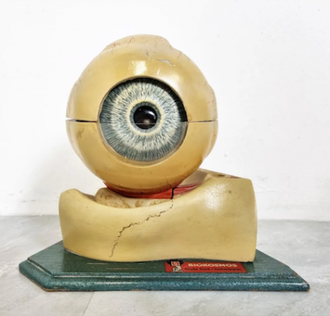Gospel in Art: If your right eye should cause you to sin, tear it out

Vintage anatomical model of the eye, Painted plaster and glass, 1960's © Christian Art
Source: Christian Art
Gospel of 14 June 2024
Matthew 5:27-32
Jesus said to his disciples: 'You have learnt how it was said: You must not commit adultery. But I say this to you: if a man looks at a woman lustfully, he has already committed adultery with her in his heart. If your right eye should cause you to sin, tear it out and throw it away; for it will do you less harm to lose one part of you than to have your whole body thrown into hell. And if your right hand should cause you to sin, cut it off and throw it away; for it will do you less harm to lose one part of you than to have your whole body go to hell.
'It has also been said: Anyone who divorces his wife must give her a writ of dismissal. But I say this to you: everyone who divorces his wife, except for the case of fornication, makes her an adulteress; and anyone who marries a divorced woman commits adultery.'
Reflection on the anatomical eye sculpture
Today's Gospel reading has a sharp edge to it. The language Jesus uses sounds strange to our ears: "If your right eye causes you to sin, tear it out and throw it away." Jesus is speaking in an exaggerated manner to capture our attention! He clearly does not mean to be taken literally. This image of tearing out our right eye links to his understanding of adultery not just as a physical act but as an intention or a desire: "whoever looks at a woman lustfully..." Jesus goes beyond the actions prohibited by the Ten Commandments to the roots of those actions in the human heart. This is the deeper virtue he calls to in his sermon on the mount, which we are reading this week as part of our daily Gospel readings.
Jesus calls for not just a change of behaviour but a change of heart, a purification of desire and intention. This interior transformation is understood elsewhere in the Scriptures to be the work of the Spirit. It is the Spirit of God who renews the human heart. It is above all in prayer that we open ourselves to the Spirit of God.
In the 1960s, anatomical eye sculptures were created as invaluable teaching aids for educators and medical students. These meticulously crafted models showcased the intricate structures of the human eye, offering a detailed and tangible resource for understanding ocular anatomy. Made from plaster and often hand-painted with precision, these models provided a realistic representation of the eye's components. These sculptures could be disassembled and reassembled, so students would get an understanding of the inner working of the eye, including the cornea, iris, lens, retina, and optic nerve, allowing students to study each component in detail. These anatomical eye sculptures were part of a broader trend toward using physical models to supplement textbooks and lectures.
LINKS
Gospel in Art: https://christian.art/
Today's Reflection: https://christian.art/daily-gospel-reading/matthew-5-27-32-2024/
Vote for the Laudamus Award 2024 for Sacred Art: www.indcatholicnews.com/news/49963


















